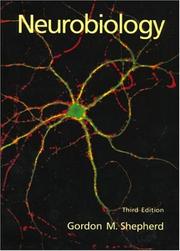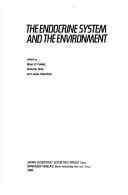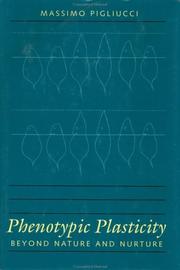| Listing 1 - 10 of 27 | << page >> |
Sort by
|
Book
ISBN: 9782100516230 210051623X Year: 2009 Publisher: Paris: Dunod,
Abstract | Keywords | Export | Availability | Bookmark
 Loading...
Loading...Choose an application
- Reference Manager
- EndNote
- RefWorks (Direct export to RefWorks)
Elasticity. --- Élasticité --- Plasticité --- Résistance des matériaux --- Plasticity --- Strength of materials
Book
ISBN: 9780226837161 0226837149 9780226837147 0226837165 Year: 2024 Publisher: Chicago: The University of Chicago Press,
Abstract | Keywords | Export | Availability | Bookmark
 Loading...
Loading...Choose an application
- Reference Manager
- EndNote
- RefWorks (Direct export to RefWorks)
Phenotypic plasticity --- Evolutionary genetics --- Variation (Biology) --- Genotype-environment interaction
Book
ISBN: 9283515579 9789283515579 Year: 1987 Volume: 154 Publisher: Neuilly sur Seine: AGARD,
Abstract | Keywords | Export | Availability | Bookmark
 Loading...
Loading...Choose an application
- Reference Manager
- EndNote
- RefWorks (Direct export to RefWorks)
539.214 --- Plasticity. Plastometry --- 539.214 Plasticity. Plastometry --- Plasticité --- Sciences spatiales --- Assemblage --- Fabrication --- Materiau metallique --- Mise a forme --- Propriete mecanique --- Usinage

ISBN: 0195088433 9780195088434 Year: 1994 Publisher: New York: Oxford university press,
Abstract | Keywords | Export | Availability | Bookmark
 Loading...
Loading...Choose an application
- Reference Manager
- EndNote
- RefWorks (Direct export to RefWorks)
Nervous System Physiological Phenomena --- Membrane Potentials --- Neuronal Plasticity --- Behavior --- Neurobiology --- Molecular neurobiology --- physiology --- Behavior - physiology

ISBN: 038715101X 4762284238 9780387151014 Year: 1985 Publisher: Berlin: Springer,
Abstract | Keywords | Export | Availability | Bookmark
 Loading...
Loading...Choose an application
- Reference Manager
- EndNote
- RefWorks (Direct export to RefWorks)
Hormones --- Adaptation, Physiological --- physiology --- Adaptation, Physiological. --- #ABIB:aeco --- Adaptation, Physiologic --- Adaptations, Physiologic --- Adaptations, Physiological --- Physiological Adaptation --- Physiologic Adaptation --- Physiologic Adaptations --- Physiological Adaptations --- Adaptation, Biological --- physiology. --- Adaptive Plasticity --- Phenotypic Plasticity --- Plasticity, Adaptive --- Plasticity, Phenotypic --- Conferences - Meetings --- Hormones - physiology - congresses --- Adaptation, Physiological - congresses
Book
ISSN: 17797365 ISBN: 9791037005731 Year: 2021 Publisher: Paris: Hermann,
Abstract | Keywords | Export | Availability | Bookmark
 Loading...
Loading...Choose an application
- Reference Manager
- EndNote
- RefWorks (Direct export to RefWorks)
Les relations humaines peuvent-elles transformer nos vies ? En croisant le discours de Bergson avec celui des neurosciences cognitives sur la notion de plasticité, ce livre ouvre l'horizon d'une philosophie des relations interhumaines. Il s'agit d'une enquête originale, stimulante et importante, qui ouvre des pistes pour de futures recherches. Y est étudiée a manière dont la plasticité ouvre sur les relations vitales entre les humains, conduisant à des transformations sociales, et à l'espérance que celles-ci doivent continuer à susciter. (éditeur)
Bergson, Henri --- Neurosciences cognitives. --- Plasticity --- Interpersonal relations --- Bergson, Henri, --- Bergson, Henri, - 1859-1941
Book
ISBN: 2902918623 9782902918621 Year: 1991 Publisher: Paris: Pour la science,
Abstract | Keywords | Export | Availability | Bookmark
 Loading...
Loading...Choose an application
- Reference Manager
- EndNote
- RefWorks (Direct export to RefWorks)
Les neurosciences en se développant balaient des croyances tenaces: l'atteinte cérébrale n'est désormais plus irrémédiable.
Neuronal Plasticity --- Brain Damage --- Nervous System Diseases --- Neuroplasticity --- Brain damage --- Brain
Book
ISBN: 9780141989303 0141989300 9780241366479 Year: 2021 Publisher: London: Penguin books,
Abstract | Keywords | Export | Availability | Bookmark
 Loading...
Loading...Choose an application
- Reference Manager
- EndNote
- RefWorks (Direct export to RefWorks)
In How We Learn, leading neuroscientist Stanislas Dehaene delves into the psychological, neuronal, synaptic and molecular mechanisms of learning. Drawing on case studies of children who learned despite huge difficulty and trauma, he explains why youth is such a sensitive period, during which brain plasticity is maximal, but also assures us that our abilities continue into adulthood. We can all enhance our learning and memory at any age and 'learn to learn' by taking maximal advantage of the four pillars of the brain's learning algorithm: attention, active engagement, error feedback and consolidation. The human brain is an extraordinary machine. Its ability to process information and adapt to circumstances by reprogramming itself is unparalleled, and it remains the best source of inspiration for recent developments in artificial intelligence. How We Learn finds the boundary of computer science, neurobiology, cognitive psychology and education to explain how learning really works and how to make the best use of the brain's learning algorithms - and even improve them - in our schools and universities as well as in everyday life.
Cognitive Science --- Brain --- Learning --- physiology --- Learning, Psychology of --- Cognitive psychology --- Neuroplasticity --- Cognitive science --- Nervous system plasticity --- Neural adaptation --- Neural plasticity --- Neuronal adaptation --- Neuronal plasticity --- Plasticity, Nervous system --- Soft-wired nervous system --- Synaptic plasticity --- Adaptation (Physiology) --- Neurophysiology --- Developmental neurobiology --- Psychology, Cognitive --- Psychology --- Psychology of learning --- Educational psychology --- Comprehension --- Learning ability --- Psychological aspects --- Science --- Philosophy of mind --- Physiology of nerves and sense organs --- neurowetenschappen --- cognitieve psychologie --- leren --- #KVHA:Psycholinguistiek --- #KVHA:Onderwijs --- #KVHA:neurowetenschap --- Leerpsychologie --- Leren leren --- Neurowetenschappen --- Hersenen --- Cognitieve psychologie --- Brain - physiology

ISBN: 0801867886 9780801867880 Year: 2001 Publisher: Baltimore (Md.): Johns Hopkins University press,
Abstract | Keywords | Export | Availability | Bookmark
 Loading...
Loading...Choose an application
- Reference Manager
- EndNote
- RefWorks (Direct export to RefWorks)
For more than two decades the concept of phenotypic plasticity has allowed researchers to go beyond the nature-nurture dichotomy to gain deeper insights into how organisms are shaped by the interaction of genetic and ecological factors. 'Phenotypic Plasticity: Beyond Nature and Nurture' is the first work to synthesize the burgeoning area of plasticity studies, providing a conceptual overview as well as a technical treatment of its major components. Phenotypic plasticity integrates the insights of ecological genetics, developmental biology, and evolutionary theory. Plasticity research asks foundational questions about how living organisms are capable of variation in their genetic makeup and in their responses to environmental factors. For instance, how do novel adaptive phenotypes originate? How do organisms detect and respond to stressful environments? What is the balance between genetic or natural constraints (such as gravity) and natural selection? The author begins by defining phenotypic plasticity and detailing its history, including important experiments and methods of statistical and graphical analysis. He then provides extended examples of the molecular basis of plasticity, the plasticity of development, the ecology of plastic responses, and the role of costs and constraints in the evolution of plasticity. A brief epilogue looks at how plasticity studies shed light on the nature/nurture debate in the popular media. 'Phenotypic Plasticity: Beyond Nature and Nurture' thoroughly reviews more than two decades of research, and thus will be of interest to both students and professionals in evolutionary biology, ecology, and genetics.
General ecology and biosociology --- Genetics --- Phenotype. --- Genotype-environment interaction. --- Nature and nurture. --- Adaptation (Physiology) --- Phénotypes --- Interaction génotype-environnement --- Hérédité et milieu --- Adaptation (Physiologie) --- Phenotypic plasticity. --- Phénotypes --- Interaction génotype-environnement --- Hérédité et milieu --- Acqui 2006 --- Phenotypic plasticity
Book
ISBN: 0521075955 9780521075954 Year: 1969 Volume: 23 Publisher: Cambridge: Cambridge university press,
Abstract | Keywords | Export | Availability | Bookmark
 Loading...
Loading...Choose an application
- Reference Manager
- EndNote
- RefWorks (Direct export to RefWorks)
Adaptation, Physiological. --- Hibernation. --- Microbiology. --- Seeds. --- Embryos, Plant --- Plant Embryos --- Plant Zygotes --- Zygotes, Plant --- Embryo, Plant --- Plant Embryo --- Plant Zygote --- Seed --- Zygote, Plant --- Plants --- Infectious Disease Medicine --- Induced Hibernation --- Hibernation, Artificial --- Artificial Hibernation --- Artificial Hibernations --- Hibernation, Induced --- Hibernations --- Induced Hibernations --- Adaptation, Physiologic --- Adaptations, Physiologic --- Adaptations, Physiological --- Physiological Adaptation --- Physiologic Adaptation --- Physiologic Adaptations --- Physiological Adaptations --- Adaptation, Biological --- Dormancy (Biology) --- Plant and Crop Sciences. Botany --- Congresses. --- Plant Physiology --- Plant Physiology. --- Adaptive Plasticity --- Phenotypic Plasticity --- Plasticity, Adaptive --- Plasticity, Phenotypic --- Adaptation, Physiological --- Hibernation --- Microbiology --- Seeds
| Listing 1 - 10 of 27 | << page >> |
Sort by
|

 Search
Search Feedback
Feedback About UniCat
About UniCat  Help
Help News
News